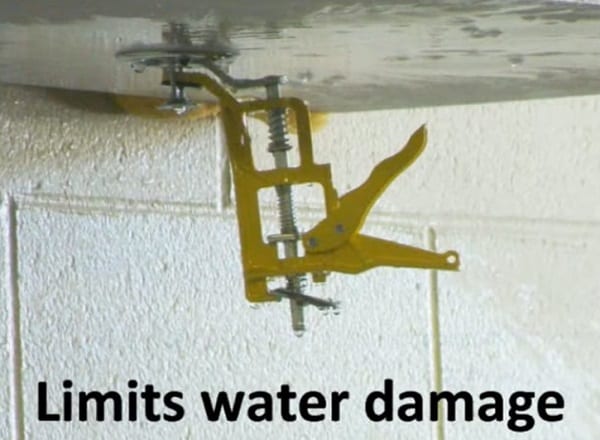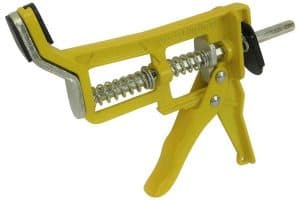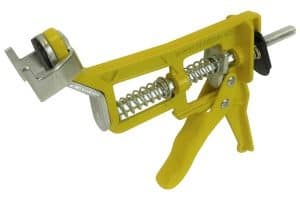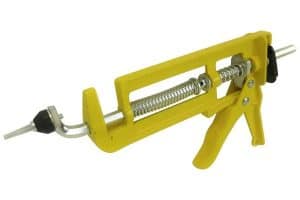A simple, effective fire sprinkler tool stops water fast
Fire sprinklers are incredibly reliable and save lives, extinguishing fires or controlling them and buying time for occupants to escape and firefighters to arrive. But sometimes, fire sprinklers activate unintentionally. The National Fire Protection Association (NFPA) reports that fire departments responded to about 33,600 unintentional fire sprinkler activations in 2014. And it’s essential to know how to turn off a sprinkler head quickly if an accidental discharge happens in your building.
Fire sprinklers can put out between 15 and 40 gallons of water in a minute, adding up to thousands of dollars in water damages. As we discussed in our previous blog, the fire sprinkler control valve is one way to turn off the water. However, it may not be the best method for the following reasons:
- Not everyone knows where the fire sprinkler riser room is or how to find the right valve.
- Sprinkler control valves are often locked open, and not everyone has the key.
- Closing the control valve can create a system impairment.
That’s where Shutgun comes in. This sprinkler stopper quickly seals fire sprinkler outlets and serves as a temporary sprinkler. By pumping a trigger similar to that of a caulk gun, the spring mechanism in a Shutgun presses and holds a rubber seal against the outlet. Once the water stops, the tool can be left in place until the sprinkler head can be replaced. A heat-sensitive soldered link maintains the compression on the seal. In the event of a fire, the link heats up, and the Shutgun disengages and falls away, allowing water to flow again.
In this article, we share an experience from a contractor who has used the Shutgun to prevent water damage—plus provide a step-by-step guide to using this fire sprinkler tool.

The Shutgun saved a QRFS customer during a high-profile project
Performance Contracting Inc. (PCI) is one of the top specialty contractors in the United States. The company completes a range of projects across the country, from hydro or industrial excavation to installing firestopping and specialty walls and ceilings. David Rekdahl, the branch safety engineer at PCI’s Portland office, says that they rely on Shutguns because they do so much work around energized sprinkler heads. “After having or seeing the damages resulting [from] a broken sprinkler head, we realized that we needed this fix,” he said.
General Foreman Josh Sandall told QRFS about a recent incident that called for a Shutgun. A PCI crew needed to quickly shut off a fire sprinkler that was activated while doing high drywall work with a scissor lift:
“One of our tapers left his sanding pole sticking out of the lift, and it struck a head as he was leaving the room. The worker yelled, and Dave, who keeps [a Shutgun] in his tools, grabbed it and had the water shut off within 30 seconds. This was a high-profile project with many high-end finishes, so [we] most likely saved a lot of money and time. The repairs were kept to a minimum due to Dave’s quick reaction.”
Dave Romero, the hero of the day, has ordered Shutguns for every member of his crew and plans to make sure they know how to use it. They will have the tool on them at all times and keep one in each scissor lift.
“Without a Shutgun,” added Rekdahl, “we would have incurred possible financial loss due to property damage and the impact on the schedule.”
How to turn off sprinkler heads with a Shutgun
Shutgun worked so quickly for the folks at PCI because it’s easy to use. All it takes is a few squeezes of the trigger. You can even do it one-handed.
Shutgun offers different models for different situations. While they all work on the same principle, their operation differs slightly. Let’s explain how to use each one, including how to safely disengage a Shutgun to remove it from a fire sprinkler head:

How to use a standard Shutgun
The standard Shutgun works on a wide range of activated sprinklers that have not been sheared off, including semi-recessed, pendent, horizontal sidewall, and upright heads. It is also the most straightforward version to use. Simply:
- Insert the adjustable jaws into the frame of an activated sprinkler head.
- Make sure the rubber pad engages with the orifice properly.
- Pump the trigger a few times until the water stops.
Check out this video to see it in action:
How to use the Sheared Head Shutgun
Whatever the cause, sometimes the diffuser plate and frame of a fire sprinkler head get broken off. In this case, you need a Sheared Head Shutgun.
Instead of engaging with the (now-non-existent) diffuser plate, as the standard model does, the Sheared Heat Shutgun uses a bracket attached to the pressure jaw. This allows the pressure jaw to pull against the base of the sprinkler head instead of pushing against the deflector plate. This model is sized for 1/2″ or 3/4″ fire sprinkler heads.
To use a Sheared Head Shutgun:
- Ensure that the prongs of the attachment engage with the base of the sheared-off fire sprinkler.
- Check that the rubber pad will engage with the orifice properly.
- Pump the trigger a few times until the water stops.
How to use the Concealed Head Shutgun
For deeply recessed or concealed sprinkler heads, you’ll need the Concealed Head Shutgun. Before this device is ready to use, you need to attach the proper probe with a nut and washer. Most sprinklers have a 1/2″ orifice and thus take the 1/2” probe, but a 3/4″ probe is also available. Replacement probes are also sold separately. Attach the right probe to Shutgun before storing it, based on the sprinklers that are present—you don’t want to fumble with nuts and washers when water is leaking everywhere.
To use the Concealed Head Shutgun:
- Insert the probe into the sprinkler head at an angle.
- Rotate the Shutgun so that the pressure jaw is inside the diffuser arms, and the probe points toward the orifice. Shutgun’s piston should be parallel to the diffuser arms.
- Pump the trigger, making sure that the pressure jaw engages the diffuser, and the probe engages the orifice.
For this one, you’ll want to watch the video to see exactly how it works.
How to safely remove a Shutgun from a fire sprinkler head
Once the water is turned off and it’s time to replace the activated sprinkler head, you need to remove Shutgun. Take care: the device is spring-loaded, and the piston can snap back quickly.
To remove the Shutgun from a fire sprinkler head:
- Stabilize the tool with one hand, keeping your fingers free of any moving parts.
- Gently pull the trigger to take spring pressure.
- While holding the trigger, put pressure on the fusible link.
- Keep pressure on the fusible link and slowly release the trigger to disengage the tool.
Shutgun turns off fire sprinklers fast!
Shutgun is a valuable tool for anyone who works around fire sprinklers. Whether it’s caused by a careless forklift operator, a hotel guest hanging their clothing on a fragile sprinkler, or a vandal, sometimes fire sprinklers activate accidentally. To stop the water fast, reach for Shutgun.
If you manage a building, consider keeping one on each floor with the fire extinguisher. If you’re a craftsman, keep one (or more) with your tools.
As our friends at PCI can attest, Shutgun can stop an activated fire sprinkler in seconds. All you have to do is align the expandable jaws and pump the trigger a few times, and the probe or rubber pad will seal off the leaking water.
Shop our selection of Shutguns and accessories to outfit your building or team.
For an all-in-one solution, consider the Complete Shutgun Kit. It features all four Shutgun models, plus accessories and spare parts. You can also shop for replacement parts, including springs, rubber pads, probes for the concealed head Shutgun, and extension pieces that let Shutgun tools work with 3/4″ NPT sprinkler heads.
The standard Shutgun works in most cases—when a sprinkler head is not a concealed or institutional model, and it has not been sheared off:

When the entire deflector plate and arms are sheared off by a heavy impact, the Sheared Head Shutgun does the job:

For concealed and deeply recessed sprinkler heads, reach for the Concealed Head Shutgun:

Locations where tampering is likely, such as prisons and psychological hospitals, often use extra-safe, tamper-resistant institutional sprinkler heads. The Institutional Shutgun works with these models:

If you have any have questions or need help placing an order, call us at +1 (888) 361-6662 or email support@qrfs.com.
This blog was originally posted at blog.qrfs.com. If this article helped you, check us out at Facebook.com/QuickResponseFireSupply or on Twitter @QuickResponseFS.


